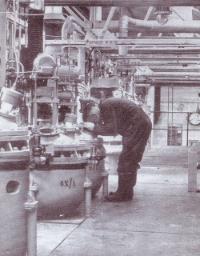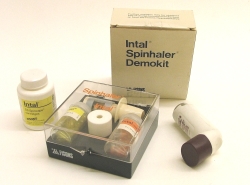Allergy and Immunity - Investigation and Treatment
The first classic description of hay fever appeared in the pages of the Medico-Chirurgical Transactions in 1819, in which the English physician John Bostock described his own periodical symptoms. In another publication nine years later and armed with a further 28 cases, he proposed to name the condition ‘catarrhus æstivus’ or summer catarrh.
Credit for the first skin test goes to a Manchester GP Charles Blackley, who in 1865 abraded a quarter inch area of his skin with a lancet, applied grass pollen grains with a piece of wet lint and covered the scarified area with an occlusive bandage. This resulted in intense itching and an urticarial weal at the test site, much like a modern skin prick test.
 Image left: Bencard skin prick testing cabinet (Tayside Medical History Museum, DUNUC 8000)
Image left: Bencard skin prick testing cabinet (Tayside Medical History Museum, DUNUC 8000)
Between 1950 and 1986 allergy injections were widely used in the UK, especially by general practitioners. However, in 1986 the Committee on the Safety of Medicines issued a report which, in the absence of a system of hospital based allergy clinics at that time, effectively abolished immunotherapy in the United Kingdom overnight. This treatment is however making a comeback within specialist centres.
In England, Sir Henry Dale and Sir Patrick Laidlaw described histamine as a potent vasoactive substance in the early 1900s. Dale studied the actions of histamine over a twenty year period and found that injecting this could produce an anaphylactic-like state, similar to what Richet had found in dogs. Sir Thomas Lewis’s ‘triple response’ of skin to mechanical stimulation in 1927 led to a theory which predicted that a diffusible ‘H-substance’ similar to histamine was released as part of a specific reaction to an allergen, but the importance of the mast cell was not appreciated until the 1950s.
Injection of adrenaline (epinephrine) for the treatment of asthma was introduced in 1903. Isoprenaline inhalers were used from the 1950s, and salbutamol inhalers were launched in 1969. Adrenaline has a similar action to ephedrine, the active ingredient of the Chinese medication Ma huang used in asthma treatment for centuries.
Antihistamines were discovered in 1933 by the Swiss Daniel Bovet, but it was to be 1944 before the first clinically useful antihistamine pyrilamine (mepyramine) for hay fever and urticaria appeared, and not until the 1980s before the problems of sedation and dry mouth were overcome with a new generation of H1-receptor antagonists.
First identified as Compound E, corticosteroids have been used as a treatment for inflammatory diseases including asthma since 1948. Glaxo Laboratories built a factory in Montrose to manufacture Cortelan in 1952, and as GlaxoSmithKline continues to make salmetorol and fluticasone for asthma to this day.
 Image right: Glaxo factory in Montrose, 1950s (Tayside Medical History Museum collection)
Image right: Glaxo factory in Montrose, 1950s (Tayside Medical History Museum collection)
Prophylactic inhaled steroids for asthma first appeared in 1951. The unfavourable risk-benefit ratio of early products were overcome with the introduction of beclomethasone in 1972, budesonide in 1987 and more recently fluticasone and mometasone.
Intramuscular triamcinolone (Kenalog) has helped many hay fever patients since the 1970s, but is much less used now following concern over side-effects raised by Drug and Therapeutics Bulletin in 1999.
Based on khella (another ancient Middle Eastern remedy for asthma), sodium cromoglycate stabilises mast cells and was found by Roger Altounyan to be effective in preventing (his own) asthma in the 1960s. Marketed as Intal Spinhaler, the inspiration for the propeller-driven device was attributed to Altounyan’s wartime flying experience.
 Image left: Intal Spinhaler Demokit, (Tayside Medical History Museum, DUNUC 4113-4114)
Image left: Intal Spinhaler Demokit, (Tayside Medical History Museum, DUNUC 4113-4114)